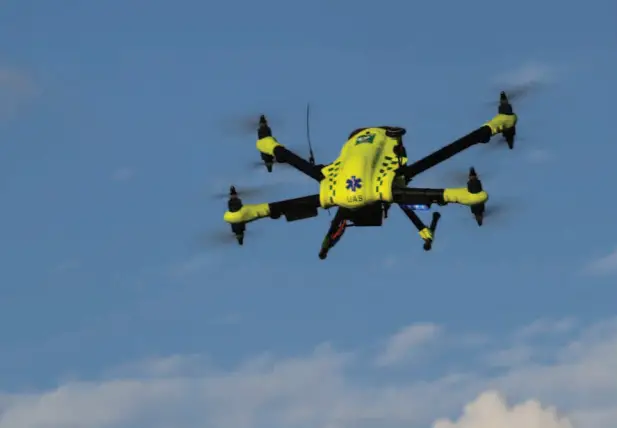
18th June 2017 Drones with defibrillators could speed response times for heart emergencies In a study involving simulated out-of-hospital cardiac arrests, drones carrying an automated external defibrillator arrived in less time than emergency medical services.
Drones carrying an automated external defibrillator could dramatically improve the response time for heart emergencies – potentially saving many thousands of lives each year – according to a study published by the Journal of the American Medical Association (JAMA). Out-of-hospital cardiac arrest (OHCA) in the United States has a low survival rate (less than 10%), with reducing time to defibrillation as the most important factor for increasing survival. Drones can be activated by a dispatcher and sent to an address provided by a 911 caller and may carry an automated external defibrillator (AED) to the location so that a bystander can use it. Whether drones could actually reduce response times in a real-life situation is unknown. Researchers from the Karolinska Institutet in Stockholm, Sweden, compared the time to delivery of an AED using fully autonomous drones for simulated OHCAs vs emergency medical services (EMS).
A drone was developed and certified by the Swedish Transportation Agency and equipped with an AED weighing 771 grams (1.7 lbs), then placed at a fire station in a municipality north of Stockholm. The drone was equipped with a global positioning system (GPS) and high-definition camera and integrated with an autopilot software system. It was dispatched to locations where cardiac arrests within a 10 km (6.2 mile) radius of the fire station had previously occurred. A total of 18 remotely operated flights were performed with a median flight distance of about two miles. The median time from call to dispatch of the EMS was 3:00 minutes, while the median time from dispatch to drone launch was three seconds. The median time from dispatch to arrival of the drone was 5:21 minutes vs 22:00 minutes for EMS. The drone arrived more quickly than EMS in all cases with a median reduction in response time of 16:39 minutes. "Saving 16 minutes is likely to be clinically important," the authors write. "Nonetheless, further test flights, technological development, and evaluation of integration with dispatch centers and aviation administrators are needed. The outcomes of OHCA using the drone-delivered AED by bystanders vs resuscitation by EMS should be studied."
---
Comments »
|








